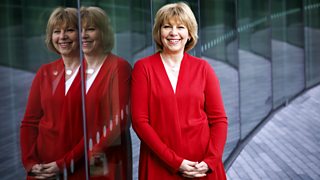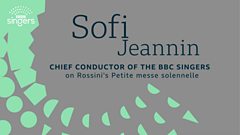
Beethoven - Symphony No. 9 in D minor
The �鶹�� Philharmonic perform Beethoven's Symphony No. 9 in D minor.
Today Penny reaches the climax of Afternoon on 3's Beethoven Symphony cycle with the work that changed the Symphony forever: his Ninth and last Symphony, transcending the orchestra with the human voice in its final "Ode to Joy".
Hillevi Martinpelto (soprano)
Karen Cargill (mezzo)
Paul Nilon (tenor)
Alastair Miles (bass)
City of Birmingham Symphony Chorus
�鶹�� Philharmonic
Gianandrea Noseda (conductor).
Ludwig van Beethoven (1770–1827)
Symphony No. 9 in D minor, Op. 125, ‘Choral’ (1822–4)
1 Allegro ma non troppo, un poco maestoso
2 Molto vivace – Presto
3 Adagio molto cantabile – Andante moderato
4 Finale: Presto – Allegro assai – Alla marcia: Allegro vivace assai – Andante maestoso – Adagio non troppo, ma divoto – Allegro energico, sempre ben marcato – Allegro ma non tanto – Poco adagio – Poco allegro, stringendo il tempo – Prestissimo
“In the repressively conservative Vienna that quickly took shape after the final defeat of Napoleon, composing an ‘Ode to Freedom’ would have been a dangerously provocative act.”
Few of Beethoven’s greatest works had easy births. His surviving sketchbooks show how long and hard he often had to struggle to bring his material to the form in which we know and value it today. Often his first thoughts seem startlingly crude or naïve compared to the finished product. But like a sculptor who senses perfection imprisoned in a slab of stone, and keeps on chiselling until he attains his ideal, Beethoven would labour away – sometimes on several works simultaneously – until he arrived at a version he could put his name to.
In the case of the Ninth Symphony the progress from the moment of conception to complete full score took at least 12 years. The first reference to a ‘symphony in D minor’ occurs in 1811 in one of Beethoven’s notebooks – at the time Beethoven was also starting work on his Seventh Symphony, in A major. Despite Beethoven’s initial enthusiasm (boosted by a rejuvenating holiday at the spa town of Teplitz), it wasn’t until the autumn of 1823 that the D minor Symphony was at last complete, though he continued to fine-tune it until the spring of 1824. That such a colossal work should have had such a long gestation is not very surprising. But it also seems that Beethoven’s overall conception changed radically during the composition process. At one point he was thinking of a purely orchestral finale – the theme he sketched for this eventually became the leading idea in the last movement of the A minor String Quartet, Op. 132. At other times Beethoven seriously contemplated a choral finale on a traditional religious text. Then his plans coalesced with a much older project: a setting of Friedrich Schiller’s Ode an die Freude (‘Ode to Joy’), which he’d first considered as early as 1798, then put on hold. At the same time, the famous ‘Ode to Joy’ theme, which sets the finale’s expanded theme-and-variations argument in motion, is clearly a reworking of – and considerable improvement on – a tune heard in the last section of the bizarre but very likeable Fantasy in C, Op. 80, for solo piano, chorus and orchestra, composed in 1808.
What was it about Schiller’s poem that had such an enduring appeal for Beethoven? On one level the Ode an die Freude has a strongly religious element– ‘World, do you sense the Creator? Look for Him beyond the stars’. But this is balanced by an unmistakably worldly, democratic message: ‘All men shall be brothers’. Beethoven may also have heard that Schiller had originally intended an ode, not to ‘joy’ (Freude) but to ‘freedom’ (Freiheit). If so, that would only have strengthened the poem’s appeal for him. In the repressively conservative Vienna that quickly took shape after the final defeat of Napoleon, composing an ‘Ode to Freedom’ would have been a dangerously provocative act. The thought that some members of the symphony’s first audience might know that ‘joy’ could also mean ‘freedom’ would only have heightened Beethoven’s enthusiasm for the project.
The most remarkable feature of the Ninth Symphony – apart from its sheer scale and extreme expressive range – is the way the work evolves from purely musical drama to vivid, sometimes almost directly pictorial setting of Schiller’s words. The first movement is the most ‘absolutely’ musical of the four: a compelling, superbly argued symphonic allegro which needs no written interpretation, but whose content is unmistakably dark. From the nebulous, hushed beginning to the spine tingling final orchestral unison at its conclusion the first movement has a momentum like a great Ancient Greek tragedy, propelled forward as though by the elemental machinery of fate. The second movement – a scherzo in all but name – has a similar classical perfection in its broad formal outlines. The main Molto vivace section has the impetus of a cosmic dance; but in the Presto trio section one can hear the orchestral instruments straining for a more vocal kind of expression. In particular the trombone writing (this is the first time these instruments are heard in the symphony) has an almost choral quality. In Beethoven’s day trombones were usually associated with religious music or with ‘supernatural’ effects in opera – such as the avenging statue in Mozart’s Don Giovanni. For the first audience in Vienna in 1824, such associations would have inescapable.
Lyricism flowers in the slow third movement, but here, very unusually in a classical era symphony, Beethoven sets the second theme in a different metre: 3 instead of the main 4/4. After this second melody has been heard twice, the Adagio unfolds in a beautiful series of variations on the initial theme, twice interrupted dramatically by full orchestral fanfares, enhanced by martial trumpets and drums. Again these do not seem to be explicable as ‘purely’ musical events – some kind of non-musical interpretation seems to be demanded, as with the ‘invasive’ trumpets and drums in the last movement of Beethoven’s contemporary Missa solemnis. A reminder of recent conflict in the midst of peace?
After the Adagio’s serene conclusion, the finale’s explosive Presto opening comes as a shock. Cellos and basses now aspire even closer to vocal expression in a series of instrumental recitatives, which conjure up memories of the themes of the first three movements. Each idea in turn is rejected, then cellos and basses begin a singing melody in D major: this is the famous ‘Ode to Joy’ theme. It grows and enriches polyphonically, then the violent Presto music breaks in again, to be followed, as before, by recitatives – but not from the orchestra, rather from a solo baritone voice: ‘O friends, no more of these sounds!’ These words are Beethoven’s own. They complete a masterly transition from semi-articulate instrumental expression to the direct utterance of the sung word. Now the finale unfolds in a huge setting of Schiller’s verses, lovingly dwelling on key images. Finally, after an ecstatic solo section for the full vocal quartet, the chorus and orchestra join in a magnificent accelerating coda. The concluding Prestissimo is left to the orchestra alone, but the message is unmistakable.
Programme note © Stephen Johnson
Duration:
Credits
| Role | Contributor |
|---|---|
| Composer | Ludwig van Beethoven |
| Orchestra | �鶹�� Philharmonic |
| Performer | Gianandrea Noseda |
| Performer | CBSO Chorus |
| Performer | Karen Cargill |
| Performer | Hillevi Martinpelto |
| Performer | Alastair Miles |
This clip is from
Featured in...
![]()
More... Symphony
More highlights from the 'Symphony' season on Radio 3 and �鶹�� Four.
More clips from Afternoon Concert
-
![]()
Charles Ives: The Unanswered Question
Duration: 06:28
-
![]()
Mahler: Adagio, from Symphony No 10 (arr. Castelletti) (excpt)
Duration: 01:43






